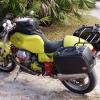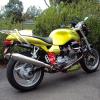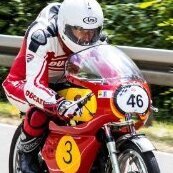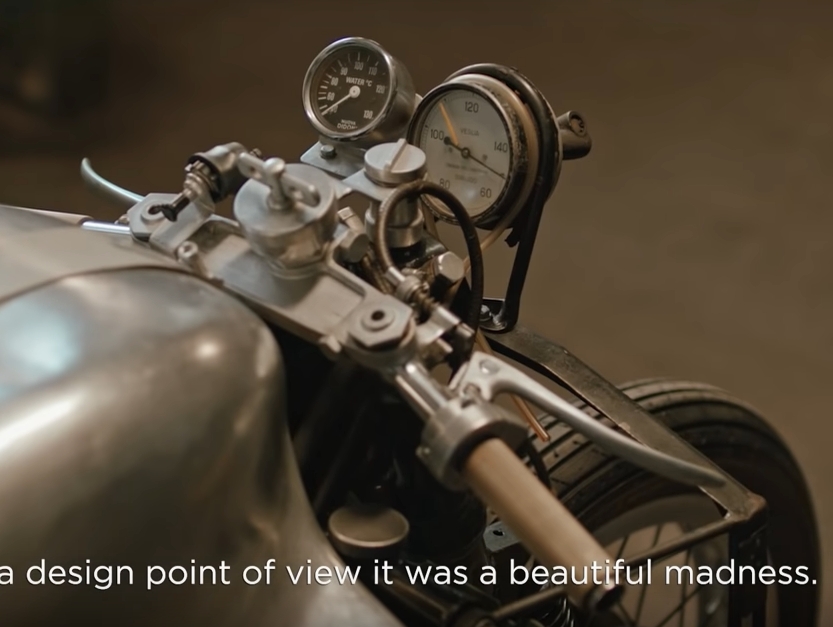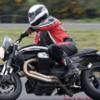Leaderboard
Popular Content
Showing content with the highest reputation on 01/17/2022 in all areas
-
Had good luck using this Motion Pro gizmo bleeding the clutch. Just make sure its fully seated..there's a gasket thing in the socket to direct the fluid thru the tube. If you decide to tackle this before a tire change, removing the starter motor et. al. provided decent access.3 points
-
You can replace your damn-near impossible to operate clutch bleeder with a remote hose from a CARC bike. OEM Part Name: Clutch Bleeder Moto Guzzi Part Number: who cares? throw it away. Replacement Part Brand or Source: Moto Guzzi Part number or other identifier: 05606630 - Referred to as Float Chamber Clutch Pipe on Harpers Parts Diagrams Differences from OEM (if any): You can actually reach it and you can bleed the clutch by yourself, while standing up. Other Compatible Vehicles: Stelvio and Griso (probably others) In this picture, you can see the new line aimed to the left of the clutch cylinder. The line is draped over the frame temporarily, but you can see the bleeder valve - just takes two wrenches. Final routing - I passed it under the frame rail and followed the starter cable up toward the battery. It terminates close to the battery. BTW - you don't have to remove swingarm to install this, but removing at least the rear wheel make it an easy installation.3 points
-
@scud has a broken cap too but just the ring. who knows maybe two broke will make one good one.2 points
-
2 points
-
I just added the remote clutch bleeder hose to the Encyclopedia. Here's a link:2 points
-
Goofman's GB has particular provenance and legacy status. They really are delightful little things, both to ride and behold. Twenty-seven years ago, I had to consider selling mine because of an impending relocation. I decided against it, but an inquiry about it brought me another lifelong friend. Motorcycling is awesome. The riding is good, too . . .2 points
-
Posted here first, low miles, turn key ready to enjoy, pictures here: https://1drv.ms/u/s!ApfE3KXJ6gPfhJxiQTteMLTKjDYJhQ?e=FdvDhg Haven't figured on a price yet, will update soon. UPDATE $6.9k is the initial ask with the intention of adjusting after some while if it's necessary to meet the market. Posted hi res pic copies. Purchased with 263.0 miles on the odo from OC Harley Davidson in Irvine CA Never down or crashed. Inquire here or text V VI II VI I IX IV VIII VII IV.1 point
-
FYI - I just pulled the bulb out of the headlight of my 2004 V11, and I found the spacer installed inside the bucket, exactly as you described.1 point
-
1 point
-
1 point
-
Sparkly is my once per year favorite. Have a bottle of Dom Pérignon standing by.1 point
-
I wear a thin cotton balaclava that protects my hearing aids as I take my helmet on or off. The shoei helmet has a ruff at the sides and back of my neck, and a visor that seals well so wind roar is muted. The hearing aid receivers partially block outside noise that doesn't come via the aids, and are set to limit loud noises, so I don't use ear plugs. I probably should have when I was younger.1 point
-
It's one of many things I had powder coated for a previous project that have come in handy on this one instead. Same with the top triple clamp.1 point
-
...and here's another weird one. The fuel door ring was cracked. Never seen that before. But it looks better in black anyway. It's a little tricky to get the thing properly seated and aligned, and I suppose you could crack it by tightening one of the four bolts that actually does something before fully seating it. (3 of the top bolts are just for looks). Maybe it could have gotten cracked with some extreme force backward against the open fuel door.1 point
-
1 point
-
This also makes you (us?) "perfectly select humanoids" of which there are, evidently, "few ." [Your Moderator does, of course, paraphrase and otherwise jack around with syntax ] > . . . If @po18guy doesn't forgive this transgression, I owe him (another) beer. . . . <1 point
-
Thx 80CX. I've got the same part securely fastened to the bike. I reassembled the headlight using the "spacer" about that bottom center screw. The minor corrosion deposits on the spacer at each end aligned with deposits on the screw, and along with the screw/spacer OD/ID consistency..well....too much of a coincidence not to believe that's where it was installed.1 point
-
Good info. BSANUT already replied to me and said "I know for sure they don't make kits for 16 mm Master cylinders anymore." So that's a bummer. And he doesn't have 12 mm kits in stock. For the record: Front brake takes 16mm. Clutch 12mm. Rear brake 11mm. So maybe I should disassemble my spare masters and keep the springs and other bits with the rest of my unobtainium.1 point
-
It's sitting on a shelf in my garage. I have no use for it. It's far from perfect and I'm certainly not looking to get rich from it. I could send some good pics if you want to PM me a #.1 point
-
1 point
-
The previous owner thought it to be a TT. When I bought it this past July It had a Tenni cowl, and a homemade brake light attached to the fender bracket.1 point
-
That is refreshing to see. See Docc.......... I told you there are still a few out there. Ciao1 point
-
1 point
-
No - that one uses the four treaded fittings on the swingarm, same as the stock one - so it has those four long CF "legs". The Ghezzi Brian one comes with a bracket that mounts with the lower shock-mount bolt. After installation, it looks like it's just floating over the tire. Here is a close-up of the bracket and how it mounts to the lower shock-bolt: Here is the fender from the side: And as luck would have it... the Nero came with the other type of fender. It was beat up (deeply gouged and some chunks taken out). Trash hadn't gone out yet, so I was able to lay it over the top of the installed GB fender for this photo. Surprisingly, you could mount that fender without removing the GB one (you can see it peeking out in a few spots). And if you look carefully, you can see the GB bracket too.)1 point
-
Hey Scud, On the top of the master cyl. there should be a seven or eight digit number stamped into the flat boss. The last two numbers will be the diameter ie 16. BSANUT on ebay usually has an assortment of Brembo stuff. Paul B1 point
-
1 point
-
1 point
-
On my 2003 Lemans, riders left, there is an similar looking piece at the bottom of an adjustment contraption that adjusts the aiming? of the headlight bucket. Mine has a slot cut in the bottom for a screw driver, and appears to be threaded and mounted with a slotted boss at the top to locate it on the bracket, then passes up through the middle of a spring with a nut at the top. Just a wag but yours is probably a variation of the same mechanism in that location with a slightly different design.1 point
-
Thanks for the offer, @Randown! Just a note that Randown has been a member here since 2009. Nice Ballabio! Rare to see them in grey . . .1 point
-
1 point
-
Guzzis are quite idiosyncratic. It's just that they idioSYNCH perfectly with a select few humanoids.1 point
-
Some things aren't rational. For proof of that, I can look in the garage.1 point
-
Heh, well, I do see that after mySport turned over 200,000 km, three months ago, I've only ridden it four times. No wonder the unsettling dream. A motorcyclist cannot live by battery charging alone . . . . . .1 point
-
@dangerous probably had a moment like that in 2015. When I first began to look at Guzzis, DD offered me some advice. Mostly beer drinking, but there was some gems of wisdom. I asked if he would sell his Nero Corsa to me. He made a choking noise, then a lot of profanity. I took that as a "NO".1 point
-
my comeback to the to the next reference to my advancing age1 point
-
1 point
-
Ok interesting. On my bike with the old/original engine it exhibited a distinct cough at the typical area but only under certain atmospheric conditions it seemed. I couldn't get it do do it at times when I was deliberately trying. The engine definitely has a failure to combust on one cylinder when it happens and I don't see any reason why it would be a random failure in the ignition system itself. Almost feels like the engine loads up on fuel and then fails to burn for a cycle and clears. You change the ECU and even with different maps it clears the problem which is interesting. My Daytona engine with an identical Efi system save for the TPS has always been fine even with the ecu that ran the 2 valve engine. Ciao1 point
-
When I was in Italy, a colleague had the 930 Turbo. The distinctive flat 6 sound of the air cooled version is unmissable. Before the 996, I had an S2000, and the handling was superior! Alternatively....1 point
-
another centennial documentary about Moto Guzzi done by the community of Mandello del Lario with a different perspective that i found interesting. and i also liked the sound of lombardian italian voices1 point
-
I sat on the black frame burgundy that I now own at a motorcycle show in Indianapolis, and was enchanted enough to stay in touch with the small "dealer" in a small town north of mine. I made monetary rationalizations and negotiations and bought it. The feedback from riding was unlike anything else I'd ridden and since it isn't the easiest machine to ride, it keeps one's attention more active in my opinion. Mountain roads in Virginia, West Virginia, North Carolina, etc. sealed the affection. Then the dreaded electrical gremlins came, and it sat languishing for several years in the garage. A crash ( obviously on a different bike) left me grounded and slightly spooked for a couple years. When I got the desire to return to riding back, no mechanic would touch it without a suitcase full of unmarked bills and Methuselah's scheduling. Somewhere I heard the phrase "If it's going to get f***ed up you might as well do it instead of paying for someone else to. " Around that same time I remembered this forum and was encouraged. The first startup after relay exchanges and the "decent tune up " brought tears to my eyes, and I thank you all...1 point
-
1 point
-
BREMBO PARTS This place has good prices on some Brembo parts like master cylinders and calipers..ships fast and seems like a nice guy on the phone Many of the earlier Ducati's like the 748/996/Monsters use the same stuff as the V-11's https://store.bevelheaven.com/index.php?p=home1 point
-
Urban Guerrilla Motorcycle riding tips for in the city writer: Nick Ienatsch This article was originally published in the August 1995 issue of Sport Rider. Ten years ago I signed on at Motorcyclist magazine and began commuting to work on a motorcycle over the busiest freeways and streets of Los Angeles. In those 10 years of commuting, two staff members had commuting accidents, neither of which caused significant damage or pain. That's five to seven editors riding to work every working day for 10 years. If we were the survey panel, the conclusion would be that commuting on a motorcycle is an extremely safe way to get to work. And with the proper skills, it can be. Experience is a great teacher, but an often painful one. To help shortcut experience, we've compiled five basic steps to existing in traffic to help get commuters out of their cars and onto motorcycles. You'll save time (one of the few nonreplenishable resources we have!) and reduce parking problems, and your work day will begin and end with less stress and more pleasure. One thing we know for sure: That sport bike in your garage isn't just for Sunday mornings. URBAN GUERRILLA STEP ONE: TRUST NO ONE This missing mirror lens blinds the driver to your presence until you are alongside and is a detail you must learn to automatically recognize and avoid as you scan traffic. Learn to rely on one person, and one person only: yourself. Be paranoid. When you see a dented, dirty or neglected car, be especially paranoid. Dents are a rolling history of mistakes, and you don't want to be involved. Dirt and neglect show disinterest, and that disinterest probably bleeds into their driving as well. Experience has taught us to watch for particular car types in addition to neglected cars. Volvo works hard to promote the safety of its cars, and that means some owners of Volvos buy them because they know they're going to be in an accident. Sure, it's an unfair generalization of Volvo owners, but it's an observation made after a decade in Los Angeles. Watch for minivans. They're usually purchased to carry the kids, so the driver is often dealing with much more than the road. Beware of high-performance cars in a hurry; a modern car can accelerate and change lanes surprisingly quickly, so give them room if they're driving aggressively. Give four-wheel drive pickups some room because (another unfair generalization) they're often driven by aggressive young men who believe that might makes right. What car types can you trust? None. URBAN GUERRILLA STEP TWO: AVOID BLIND SPOTS How other drivers interpret your actions has a great deal to do with urban riding skill. If this rider uses his turn signal to show his intention to make a right turn on the upcoming street, the Volkswagen driver exiting the 7-Eleven may assume the rider is pulling into the 7-Eleven and mistakenly accelerate directly into the bike's path. In this case, the rider must stay in the left side of the right lane and signal his right turn immediately before the street-and keep a close eye on the VW. If one thought rules your urban riding, let it be this: Stay out of blind spots. If you can't see the driver's face in the car's mirror, that driver can't see you and you simply don't exist. Place blind-spot avoidance on top of your priority list for urban survival. Use acceleration, deceleration and lane position to "ride in the mirrors" of the cars around you. Develop a blind-spot warning buzzer that blares every time you approach a blind spot. The Highway Patrol teaches its riders to constantly move through traffic, to ride slightly (slightly!) faster than traffic and move through blind spots rather than sitting in them. Good advice. Of course, just because you're riding in the mirrors of a car doesn't mean that driver will use that mirror before changing lanes into you. Position yourself so that if the driver fails to see you in the mirror, you still aren't in danger of getting tagged. You will know when you're riding well and staying clear of blind spots because you are no longer using your horn to warn encroaching drivers of your presence; they've already seen you in the mirror, alongside or ahead. In fact, our response to "loud pipes save lives" is "get out of the blind spot." URBAN GUERRILLA STEP THREE: BE DEFENSIVE, BE AGGRESSIVE By predicting this car's last-second freeway flop, this rider has made plenty of room for the expected mistake. Avoid passing on the right, and never pass immediately before a freeway exit, intersection or driveway; give the driver a chance to drive poorly without your involvement. Accelerate ahead or fall behind. Combining defensive tactics and aggressive riding will create a riding portfolio that will weather any storm. The secret is knowing when to use each of the tactics. After all, blasting aggressively down Main Street is an open invitation for trouble. Conversely, creeping slowly down Main Street invites different but still deadly trouble, putting you at the mercy of other drivers' skills-or lack thereof. Defensive riding means being aware of your space and maintaining that space by positioning yourself in surrounding traffic. Riding defensively is a way of looking at traffic to predict its effect on you, and making sure that effect is minimal. Riding aggressively is much less a way of riding than an applied technique to be exercised only occasionally. As motorcyclists, we must put ourselves in view, and sometimes that means a bit of aggressive throttle use to come up even with a driver's window. Simply put, sometimes slowing down is extremely dangerous and some aggressive acceleration or lane changing is called for. Correct lane positioning will allow you to be seen and keep you away from danger. This rider approaches the cab in the right side of his lane so the cab driver will see him in the cab's mirrors. As the rider approaches the cab's blind spot, he moves left to gain valuable space in case of a sudden lane change. Create your own traffic destiny. Put yourself in a position with an escape route if your worst-case predictions come true. Look for traffic patterns and try to move through traffic, rather than sit within a knot of traffic. The time you become lethargic will be the time somebody parks a Suburban in your lap at 60 mph. URBAN GUERRILLA STEP FOUR: MAKE ROOM FOR OTHERS' MISTAKES In case you haven't noticed, drivers make mistakes. Dozens of them, from no turn signal to last-minute freeway exits to locked brakes at a yellow light to-well, how long a list do you need? America's current driver's training programs aren't going to correct America's drivers in the foreseeable future, so the secret is to plan on and predict the mistakes and make sure you're not affected. In other words, give 'em room to screw up. A car's blind spot varies according to the vehicle, mirror size and mirror adjustment. Anytime you're parallel to a car, truck or van, you're in the most dangerous spot on the road. Learn to move through this Death Spot aggressively; don't ride in a blind spot, even for a few seconds. Understand this: You won't change the mistakes being made out there, but by recognizing and giving them room to happen, you won't be negatively affected by them either. There's no reason to get upset, violent, aggressive or reactionary; once you begin to make room for mistakes, it becomes almost humorous to watch the stupidity around you because you will no longer be taken by surprise or put in danger. URBAN GUERRILLA STEP FIVE: SLOW DOWN IN TOWN Speed itself doesn't kill, but it sure makes those sudden stops painful. Basically, too much speed makes us unreadable. The car driver looks down the street, sees a headlight approaching at what he guesses to be the speed limit, and proceeds through the intersection. Unfortunately, the bike is doing double the speed limit and slams into the side of the car. Whose fault is it? Not the car driver's. Slow down to be seen; slow down to avoid being misread. An ugly chain reaction can be started when a car squeezes into the right lane of a crowded freeway, and you'll be affected if you don't take action. Predict possible outcomes and place yourself safely in surrounding traffic. Often that means safely accelerating ahead of the mess. Slowing down allows you to stop before becoming involved in someone else's mistake. Even if you're the Kevin Schwantz of braking, it takes more distance to stop a bike from 50 mph than it does from 30 mph; that extra distance usually isn't available to urban guerrillas. Slowing down gives your brain a chance to notice things and more time to react. Your peripheral vision widens and you relax enough to read and predict traffic. Try walking down the supermarket aisle and reading labels, then try running down the same aisle. Now imagine all those soup cans are about to jump into your path and you'll see how slowing down affects your perception. There are plenty of places to go fast, but in and around traffic isn't one of them. If you can't slow down in town, put me in your will. URBAN GUERRILLA BONUS STEP: PRACTICE Intersections are our toughest challenges. This rider is moving into the right side of his lane to gain and give the most unobstructed view possible, a good idea since the car waiting to turn left is all but blinded by the UPS truck. Slow down, cover your brakes, and use your lane to position yourself for maximum conspicuity. When everything goes wrong and the above five steps fail to keep you in safety's arms, you'd better be a good motorcycle rider. Get to an empty parking lot and practice braking; take a Motorcycle Safety Foundation Experienced RiderCourse. Experiment with flicking lane changes. Become intimately familiar with the effects of countersteering, experimenting with differing pressures on the handgrips. Practice quick glances in the mirrors and hurried looks over your shoulder, as if you were initiating an emergency lane change. Use your turn signals in all conditions so that you'll remember to cancel them when things get stressful. Know the route you and your neighborhood commuters take on the way to the freeway and study the mistakes being made; when you're not on your bike, watch traffic patterns and instances that would get a rider in trouble. All this is practice, and it's just as important for the urban guerrilla as it is for the expert-level roadracer. You can't win a trophy with your commuting prowess, but you can step out of the car or bus and add two irreplaceable things to your life: time and enjoyment.1 point

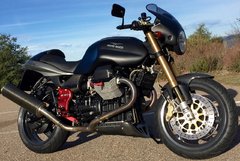
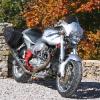
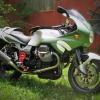
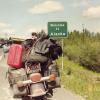
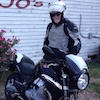

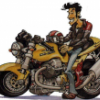


.thumb.jpg.6ca2ad474f505dd9ad78d32a82ac6c8a.jpg)
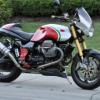
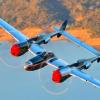
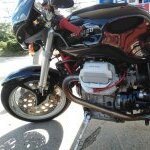
.thumb.jpg.ccd733fb0a189b8fd9d07ee3fc26f881.jpg)
